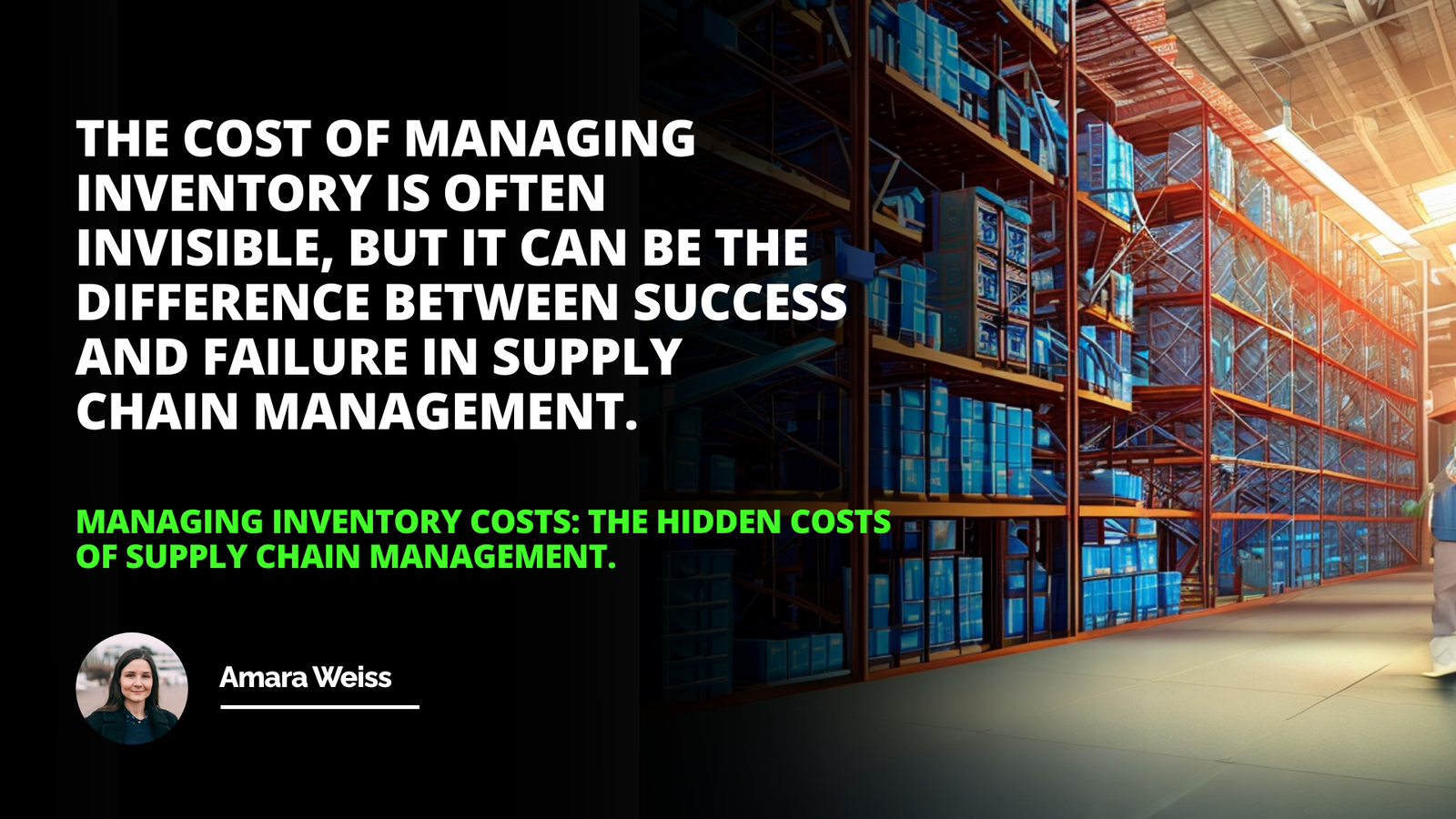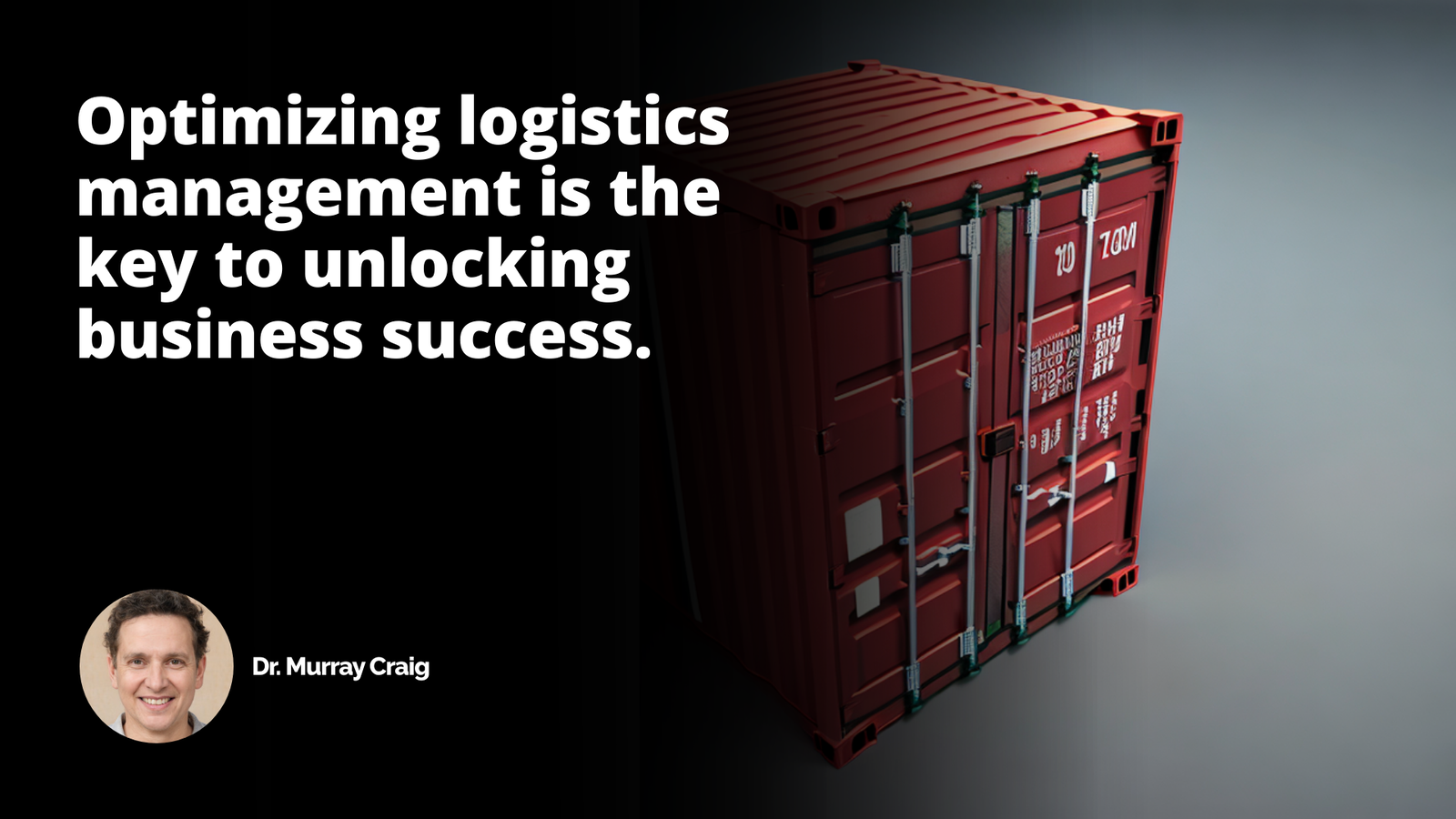
CPFR is a collaborative process that originated in 1995 from the efforts of two companies, Warner-Lambert and Walmart, to improve the accuracy of forecasted product sales. It has since been expanded to include various activities such as demand planning, inventory management, and Supply Chain collaboration.
The primary benefit of CPFR is improved forecast accuracy, and the second benefit is improved inventory utilization. CPFR can be used for both day-to-day operations and long-term strategies. By embracing this process, firms can unlock the full potential of their Logistics operations and ensure that their business remains agile and responsive.
Introduction
Definition of Logistics Standardization
Benefits of Standardization
CPFR Overview
Origins of CPFR
Unlock the Benefits of Logistics Management with CPFR
Related Course: Logistics Management Courses Online
Logistics standardization is essential in improving any business's agility and responsiveness. By standardizing a process and executing it according to a specific timetable, firms can ensure that activities occur as planned. To explore the benefits of standardization further, let’s look at one of the most well-known logistics processes, Collaborative Planning, Forecasting, and Replenishment (CPFR).
CPFR is a collaborative process that originated in 1995 from the efforts of two companies, Warner-Lambert (WL) and Walmart, to improve the accuracy of forecasted sales of Listerine Mouthwash in Walmart stores.1 WL manufactured Listerine, and Walmart bought and sold Listerine. Both firms were independently forecasting expected Walmart store sales of this product and decided to collaborate in the forecasting process. Initially, the collaboration took the form of a simple spreadsheet exchange.
CPFR has since expanded to include various activities, such as demand planning, inventory management, and supply chain collaboration. The process is designed to improve the accuracy of demand forecasts and inventory management efficiency.
The primary benefit of CPFR is improved forecast accuracy. By collaborating with partners in the supply chain, firms can gain better visibility of the demand for their products and services. This allows them to create more accurate forecasts and reduce the risk of overstocking or understocking.
The second benefit of CPFR is improved inventory utilization. By having better visibility of the demand for their products, firms can better manage their inventory levels, ensuring they have the right amount of inventory at the right time. This reduces the risk of stockouts and helps to optimize inventory costs.
CPFR can be applied to both day-to-day operations and long-term strategies. For example, CPFR can be used to plan for seasonal fluctuations in demand or to anticipate changes in customer preferences. In addition, CPFR can be used to develop long-term partnerships with suppliers and distributors to improve the efficiency of the supply chain.
In conclusion, CPFR is a robust logistics process that can help firms improve their forecasts' accuracy, optimize inventory utilization, and develop stronger partnerships with suppliers and distributors. By embracing this process, firms can unlock the full potential of their logistics operations and ensure that their business remains agile and responsive.
Regarding logistics management, CPFR is the key to unlocking success.
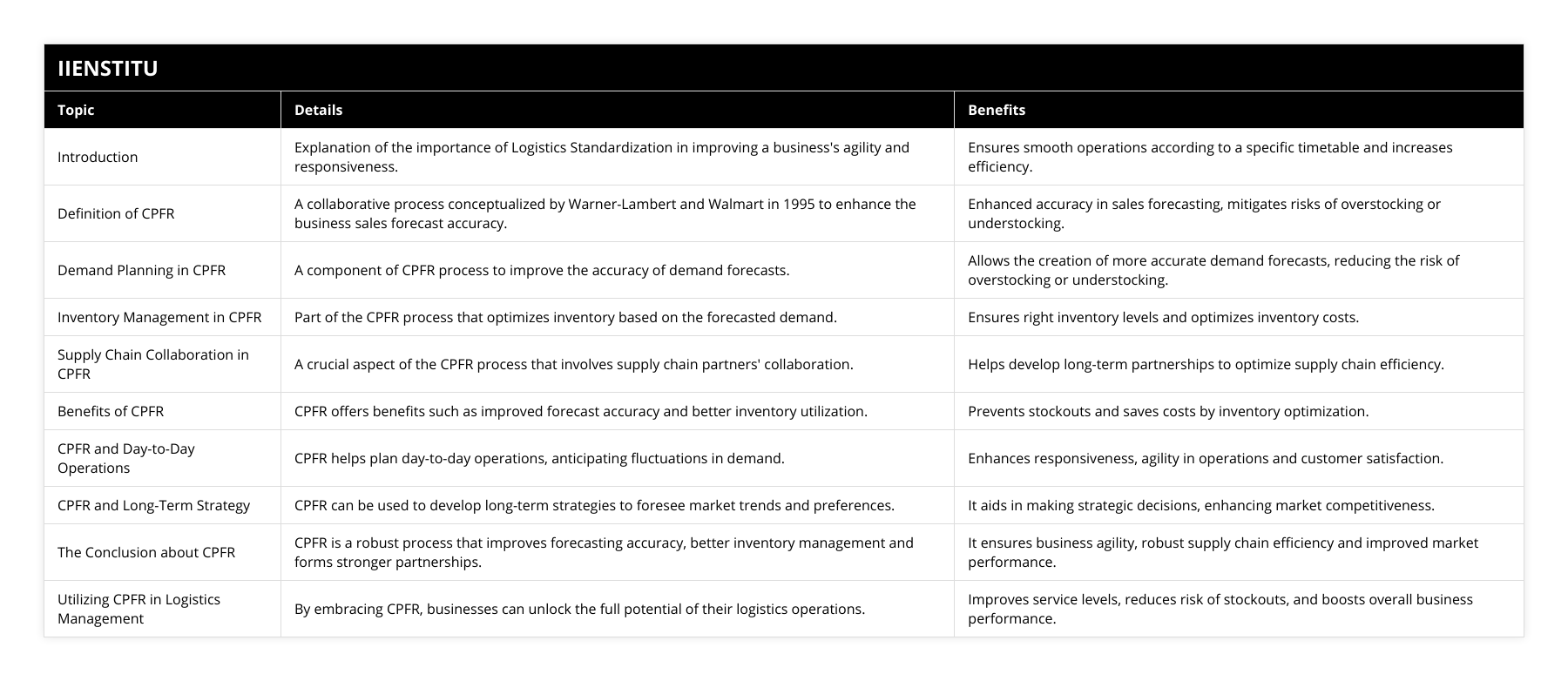
Frequently Asked Questions
What is CPFR and how does it relate to logistics management?
Collaborative Planning, Forecasting, and Replenishment (CPFR) is a system of strategic planning and logistics management that many enterprises have widely used. It involves the coordination of sales forecasts and inventory levels between two or more trading partners. By leveraging both partners' combined forecasting and replenishment capabilities, CPFR enables organizations to optimize their supply chain operations and reduce operational costs.
The core of CPFR is developing a mutually agreed upon forecast, or "joint business plan," which serves as a foundation for collaborative decision-making. This plan is based on collecting and analyzing actual sales data, market trends, and other available information. It is then used to support supply chain decisions such as inventory management, transportation planning, production scheduling, and pricing.
CPFR is typically implemented in a three-phase process. In the first phase, the two trading partners agree on a joint business plan and determine the necessary data exchange and analysis requirements. In the second phase, the two partners jointly analyze the data, identify opportunities, and develop strategies to address them. The third phase is implementing the system, which may involve changes to inventory levels, production schedules, and transportation routes.
CPFR has become increasingly popular recently, allowing organizations to maximize logistics capabilities and reduce costs. By leveraging both trading partners' combined forecasting and replenishment capabilities, CPFR enables organizations to optimize their supply chain operations and reduce operational costs. Furthermore, CPFR allows for greater visibility into inventory levels, demand patterns, and other key metrics, providing organizations with a better understanding of their supply chain operations.
In conclusion, CPFR is a system of strategic planning and logistics management that many enterprises have widely adopted. By leveraging both trading partners' combined forecasting and replenishment capabilities, CPFR enables organizations to optimize their supply chain operations and reduce operational costs. Additionally, CPFR provides organizations with greater visibility into inventory levels, demand patterns, and other key metrics, providing organizations with a better understanding of their supply chain operations.
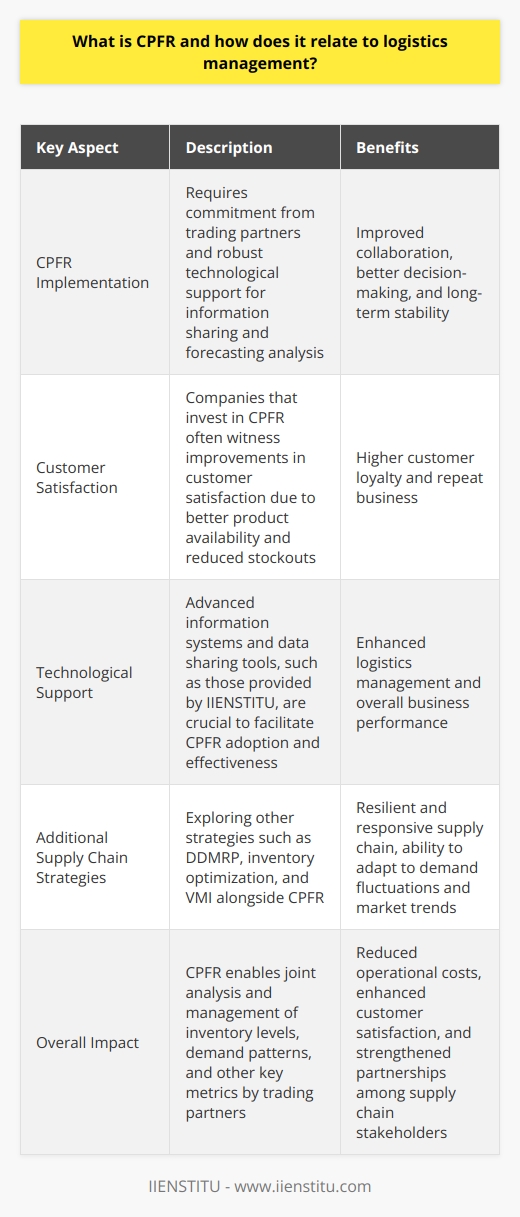
What are the benefits of using CPFR for logistics standardization?
Logistics standardization is an essential factor for the success of any business. CPFR (Collaborative Planning, Forecasting, and Replenishment) is a logistics standardization technology used to help streamline the supply chain process and improve efficiency. CPFR is a collaborative process involving all supply chain members, including suppliers, retailers, and distributors. It is used to create a shared information database to forecast demand, plan production, and manage inventory.
CPFR has many benefits for logistics standardization. First, it allows for better collaboration and communication between supply chain members. Having a shared database allows all members to access the same information and make decisions based on the same data. This helps ensure everyone is on the same page and that decisions are made promptly.
Another benefit of CPFR is that it allows for better forecasting. With a shared database, supply chain members can use the same data to make informed decisions about future demand. This helps to ensure that production and inventory levels are optimized to meet customer needs.
Additionally, CPFR helps to reduce costs by increasing the efficiency of the supply chain. By streamlining the process, there is less redundant data and fewer errors. This helps to reduce costs associated with inventory management and product delivery.
Finally, CPFR helps to improve customer service by increasing the accuracy of delivery times. With a shared database and accurate forecasting, supply chain members can be sure that orders are delivered on time. This helps to improve customer satisfaction, as customers receive their orders when they expect them.
In conclusion, CPFR offers many benefits for logistics standardization. By allowing for better collaboration and communication between supply chain members, better forecasting, cost reduction, and improved customer service, CPFR is an invaluable tool for any business looking to streamline its supply chain.
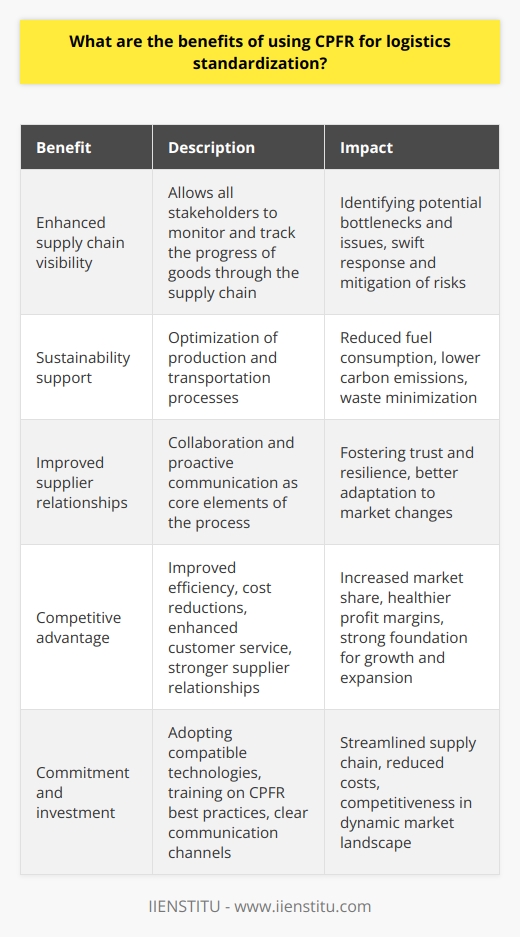
How can CPFR be applied to day-to-day operations and long-term strategies?
Collaborative Planning, Forecasting, and Replenishment (CPFR) is a potent tool that can revolutionize how companies manage their day-to-day operations and long-term strategies. CPFR is a demand-driven process that uses collaborative data analysis and sharing to improve customer service and reduce inventory costs.
CPFR helps companies better to manage the demand for their products and services. Companies can evaluate demand patterns and forecast future needs by utilizing customer data. This enables them to plan better their production, supply chain activities, and inventory levels. It also helps companies to identify opportunities to increase sales, reduce costs, and improve the customer experience.
In addition to managing demand, CPFR can also be used to create more efficient long-term strategies. For example, companies can utilize CPFR to analyze customer data and identify potential opportunities for growth and expansion. This can help them develop more effective marketing and promotional strategies and identify new product and service offerings. Furthermore, CPFR can help companies develop more effective supply chain management strategies, reducing costs and increasing profitability.
CPFR can also help to improve customer service. By utilizing CPFR, companies can better anticipate customer needs and respond promptly. This can help to increase customer satisfaction, loyalty, and, ultimately, sales.
Finally, CPFR can help to reduce inventory costs. Companies can better manage their inventory levels by analyzing customer data and forecasting future demand. This can help them avoid overstocking and dealing with costly inventory write-offs.
In conclusion, CPFR is a powerful tool that has the potential to revolutionize the way companies manage their day-to-day operations and long-term strategies. As a result, companies can better forecast demand, create more efficient processes, improve customer service, and reduce inventory costs by utilizing customer data.

What is CPFR in logistics and how does it enhance supply chain efficiency?
Understanding CPFR in Logistics
Collaborative Planning, Forecasting, and Replenishment (CPFR) refers to a logistics and supply chain management approach which focuses on coordination and collaboration between suppliers, manufacturers, distributors, and retailers. CPFR's primary goal is to align forecasting, production, and inventory management across all parties involved, ultimately enhancing overall supply chain efficiency.
Streamlining Forecasting Processes
One way CPFR enhances supply chain efficiency is by streamlining the forecasting process. By pooling information from different stakeholders, CPFR generates a more accurate demand forecast, reducing overstocks and stockouts. Consequently, this leads to improved product availability and customer satisfaction.
Optimizing Inventory Management
CPFR also aims to optimize inventory management by sharing data among trading partners. Real-time visibility into the supply chain enables all parties to monitor inventory levels efficiently, preventing surplus stock or stock shortages. This optimized inventory management ultimately reduces costs, lead times, and warehousing needs.
Reducing Lead Times
The timely sharing of information between parties in the supply chain allows for more accurate production and delivery scheduling, resulting in reduced lead times. With enhanced visibility, suppliers can react more swiftly to fluctuations in demand, allowing for more efficient transportation and distribution of goods. Shorter lead times reduce the risk of stockouts and offer better adaptability to changing market conditions.
Enhancing Collaboration
A central component of CPFR is its collaborative nature, highlighting the importance of relationships and trust among supply chain partners. Open communication lines lead to smoother operations, early identification of potential bottlenecks, joint problem-solving, and a shared strategic vision.
Maximizing Cost Savings
Lastly, CPFR's holistic approach to supply chain management results in cost savings across the entire supply chain spectrum. By reducing stock waste, increasing inventory turnover rates, streamlining transportation, and enhancing forecasting accuracy, CPFR enables businesses to remain competitive and cost-efficient in an increasingly globalized market.
In conclusion, CPFR significantly enhances supply chain efficiency by fostering collaboration among stakeholders, streamlining forecasting processes, optimizing inventory management, reducing lead times, and maximizing cost savings. As supply chains grow in complexity and global reach, the adoption of CPFR principles will remain crucial for organizations seeking to ensure competitiveness and maintain profitability.
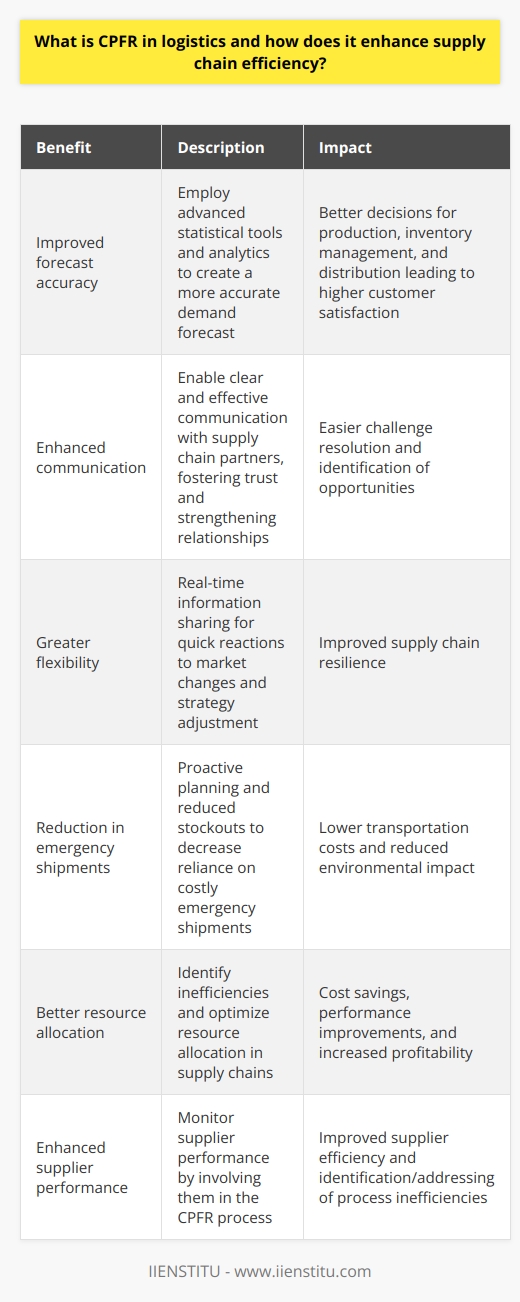
What are the potential advantages of implementing a CPFR program in a company's supply chain management process?
**Enhanced Forecasting Accuracy**
A significant advantage of implementing a Collaborative Planning, Forecasting, and Replenishment (CPFR) program in a company's supply chain management process is the potential for enhanced forecasting accuracy. With CPFR, companies can collaborate with their supply chain partners to share data and strategies, resulting in more accurate demand forecasts. Better demand forecasts lead to optimized production, inventory levels, and resource allocation, improving overall efficiency.
**Reduced Stockouts and Overstocks**
By improving forecasting accuracy, CPFR also helps minimize stockouts and overstocks. When companies can confidently predict demand, they can order and produce the necessary quantity, reducing the risk of losing sales due to stockouts or holding excessive inventory. This balance optimizes warehouse space and minimizes inventory carrying costs, ultimately enhancing profitability.
**Increased Supply Chain Visibility**
Implementing a CPFR program provides increased visibility into the entire supply chain. Transparent, real-time information sharing with partners allows companies to monitor their supply chain better and proactively address potential disruptions or bottlenecks. By resolving issues quickly, companies can maintain operational efficiency and ensure customer satisfaction.
**Strengthened Business Relationships**
CPFR fosters collaboration between supply chain partners, encouraging open communication and stronger relationships. This collaboration leads to more effective problem-solving and decision-making, as companies can leverage each other's expertise and resources. Strong business relationships encourage long-term partnerships, which can drive further efficiency improvements and create greater value for all involved parties.
**Sustainability Benefits**
With optimized inventory levels, production planning, and resource allocation, CPFR programs can reduce waste and the overall environmental footprint of supply chain operations. By minimizing overstocks and stockouts, companies can reduce their carbon emissions and energy consumption associated with transporting, storing, and disposing of excess inventory. This environmentally friendly approach to supply chain management can also positively impact a company's reputation and brand image.
In conclusion, implementing a CPFR program in a company's supply chain management process offers multiple advantages, including enhanced forecasting accuracy, reduced stockouts and overstocks, increased supply chain visibility, strengthened business relationships, and sustainability benefits. By adopting CPFR, companies can streamline their operations and maximize supply chain efficiency, leading to reduced costs and improved profitability.
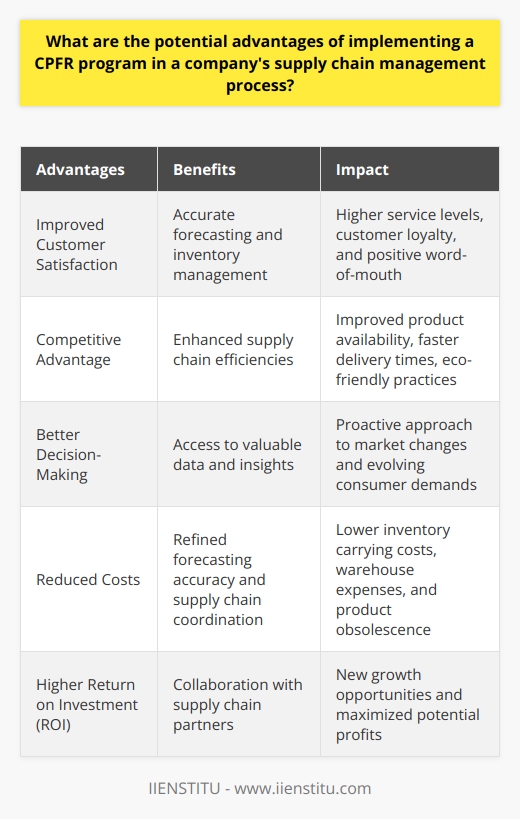
How does CPFR contribute to the overall effectiveness and sustainability of a company's supply chain operations?
CPFR's Impact on Effectiveness
Collaborative Planning, Forecasting, and Replenishment (CPFR), as a supply chain management approach, enhances the effectiveness of a company's supply chain operations in various ways. One major contribution of CPFR is the improved communication and collaboration between business partners. By collaborating and sharing vital information, businesses can make informed decisions, reduce lead times, and enhance order accuracy.
Inventory Management and Cost Reduction
CPFR significantly aids in optimizing inventory management, as both parties (suppliers and retailers) work together to determine appropriate inventory levels. Consequently, this proactive approach enables them to manage fluctuations in supply and demand effectively, reducing the negative impacts of stockouts or excess inventory. Moreover, CPFR helps in lowering operating costs, as businesses can identify and eliminate wasteful practices and minimize the need for safety stock.
Sustainability Benefits of CPFR
In addition to the above benefits, CPFR contributes to the overall sustainability of a company's supply chain operations. Implementing CPFR reduces waste by eliminating unnecessary inventory, decreasing lead times, and minimizing supply chain disruptions. Furthermore, better communication and collaboration in the supply chain facilitate innovative solutions for more sustainable manufacturing and transportation processes.
Customer Service and Competitive Advantage
CPFR enhances a company's ability to satisfy customer demands and attain a competitive edge in the market. By effectively managing inventory and improving demand forecasting, businesses can offer superior customer service and timely delivery of products. As a result, customer satisfaction increases, and companies can build long-term relationships with loyal clients.
In conclusion, CPFR is an essential strategic approach for companies aiming to optimize their supply chain operations. By enhancing communication, reducing costs, and promoting sustainability, CPFR enables businesses to deliver better customer service, maintain a competitive advantage in the market, and ensure the long-term success and viability of their supply chain operations.
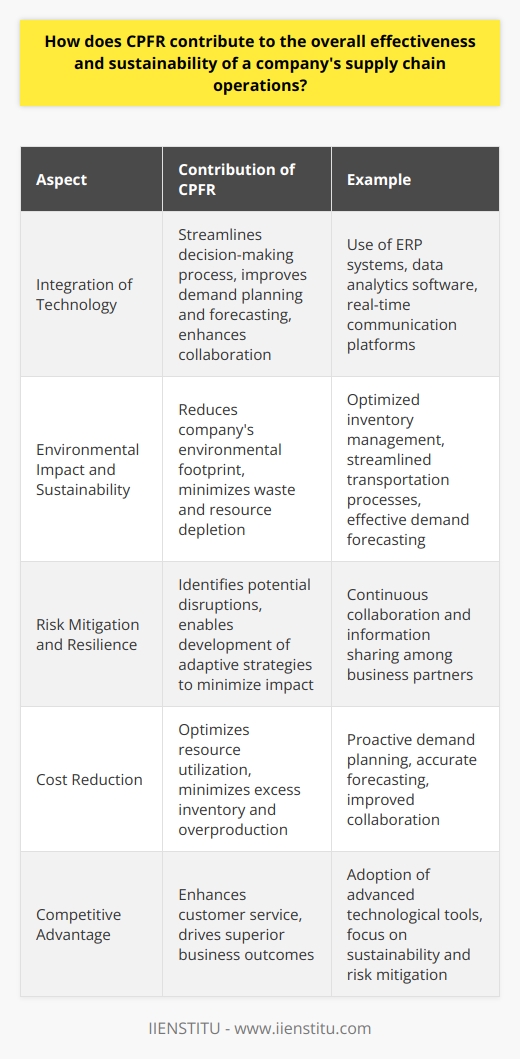
What are the key factors that contribute to the successful implementation of a CPFR program in supply chain management?
Key Factors for Successful CPFR Implementation
Establishing Trust and Cooperation
The first key factor for the successful implementation of a Collaborative Planning, Forecasting, and Replenishment (CPFR) program is fostering trust and cooperation among the involved parties. In a supply chain, the partners must trust each other's intentions, be willing to share crucial information, and collaboratively develop solutions.
Shared Objectives and Metrics
Another essential factor is establishing common objectives and SCM key performance indicators (KPIs) for the participating organizations. This ensures that all partners are working toward the same goals and can align their efforts. Well-defined and measurable KPIs can track progress and improve decision-making.
Data Accuracy and Visibility
Accurate and readily available data is vital for CPFR implementation. This includes real-time information sharing on inventory levels, sales, promotions, and customer demand. Ensuring data visibility across the supply chain enables more accurate forecasting and better collaboration among the partners.
Technology and Integration
A robust technological infrastructure and seamless integration of systems are necessary for effective CPFR implementation. Investing in advanced software platforms, such as Enterprise Resource Planning (ERP) and Supply Chain Management (SCM) systems, can optimize data sharing and communication between trading partners.
Adaptable Framework
Implementing a flexible CPFR framework allows participants to modify processes, systems, and strategies to suit their unique business needs. This can improve the scalability and sustainability of the program, enabling it to evolve and adapt over time.
Continuous Improvement
Lastly, successful CPFR implementation requires a commitment to continuous improvement, which involves regularly reviewing the program, identifying weaknesses, and implementing necessary changes. This enables the supply chain partners to learn from their experiences, improve efficiency, and ensure the program remains effective in achieving its objectives.
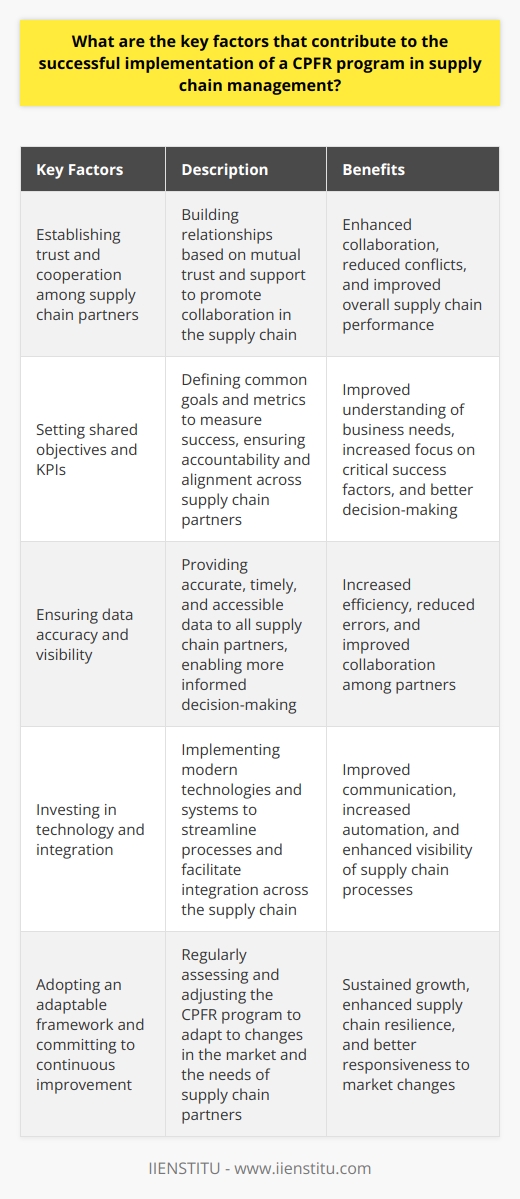
How do CPFR programs address the challenges of demand uncertainty and supply variability within the supply chain?
Addressing Demand Uncertainty
Collaborative Planning, Forecasting, and Replenishment (CPFR) programs play a crucial role in mitigating the challenges of demand uncertainty and supply variability within the supply chain. At their core, CPFR programs emphasize collaboration and coordination among supply chain partners, fostering a transparent and proactive environment.
Enhancing Forecast Accuracy
CPFR programs address demand uncertainty by focusing on improving forecast accuracy. Through regular communication and data sharing among supply chain partners, these programs enable accurate demand forecasting, taking into account various factors such as historical sales, market trends, and promotions. Consequently, improved forecast accuracy helps supply chain decision-makers better anticipate demand variations, enabling them to make informed decisions regarding inventory management and production planning.
Reducing Supply Chain Inefficiencies
In addition to enhancing forecast accuracy, CPFR programs help reduce supply chain inefficiencies by optimizing resource allocation and facilitating coordination among partners. Such programs enable better alignment of demand and inventory levels, leading to reduced stockouts and excess inventory. Consequently, organizations under a CPFR program can achieve cost savings, lower lead times, and increased customer satisfaction.
Promoting Responsiveness to Supply Variability
CPFR programs also address supply variability by improving the responsiveness of supply chain partners to fluctuations in demand. They allow for real-time communication and adjustments to production and distribution plans in response to changing demand patterns. This increased responsiveness enables partners to adapt quickly to any supply disruptions or fluctuations, minimizing the impact on overall supply chain performance.
Strengthening Supplier Relationships
Another way CPFR programs address the challenges of demand uncertainty and supply variability is by strengthening relationships among supply chain partners. Through close collaboration and open communication channels, organizations can build trust and foster long-term partnerships. These stronger relationships lead to better information sharing and cooperation, enabling a more resilient and agile supply chain capable of coping with uncertainties and variability.
In conclusion, CPFR programs effectively address demand uncertainty and supply variability by enhancing forecast accuracy, reducing supply chain inefficiencies, promoting responsiveness to fluctuations, and strengthening supplier relationships. By fostering collaboration and coordination among supply chain partners, CPFR programs enable organizations to build a more agile and resilient supply chain, better equipped to handle the uncertainties and variability inherent in today's complex and dynamic business environment.
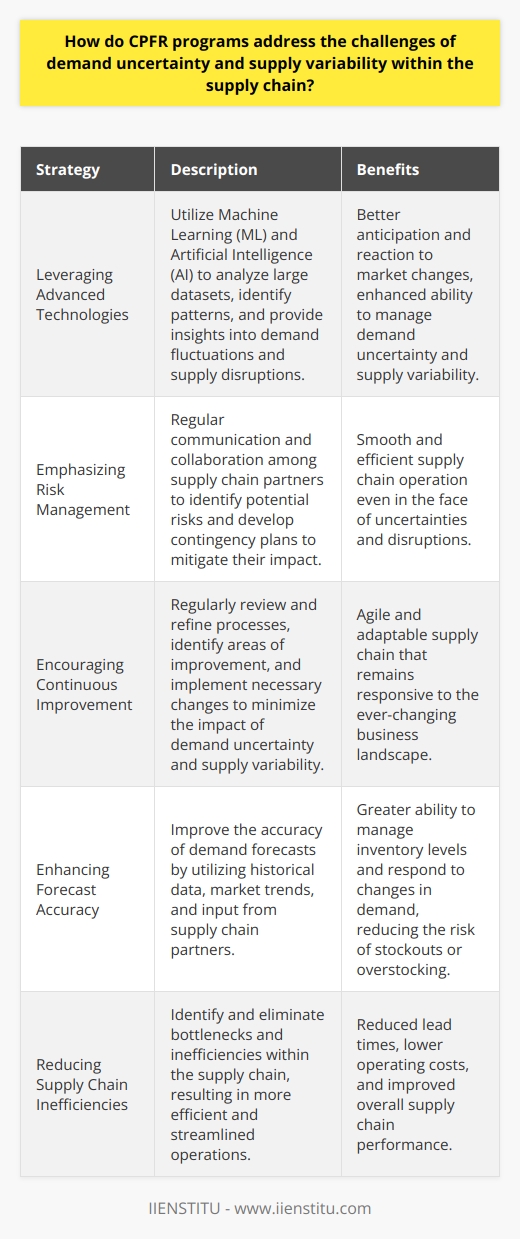
In what ways do CPFR applications enhance collaboration and communication among supply chain partners?
Enhanced Information Sharing
One significant way CPFR (Collaborative Planning, Forecasting, and Replenishment) applications enhance collaboration and communication is by facilitating information sharing among supply chain partners. These applications provide a platform where partners can exchange crucial data, such as demand forecasts, inventory levels, and shipping schedules, allowing for greater visibility of the entire supply chain process. This increased transparency enables partners to make better-informed decisions, leading to optimal utilization of resources and more efficient operations.
Improved Forecast Accuracy
Another advantage of CPFR applications is improved forecast accuracy. By enabling real-time data exchange between partners, CPFR allows for the incorporation of up-to-date market trends and emerging consumer preferences into demand forecasts. Consequently, supply chain partners can continuously adapt their production and distribution plans to meet changing customer demands, resulting in fewer stockouts or excess inventory, ultimately leading to cost savings and improved customer satisfaction.
Streamlined Operations
CPFR applications also help streamline operations across the supply chain, enhancing collaboration and communication among partners. They facilitate the development of joint performance metrics and the implementation of best practices to optimize supply chain processes. By promoting a more collaborative environment, these applications foster greater trust and cooperation between supply chain partners, enabling them to work together more effectively and efficiently to address challenges and achieve common objectives.
Reduced Lead Times
Another benefit of CPFR applications is the reduction of lead times for various supply chain processes. Access to real-time information enables supply chain partners to promptly identify potential disruptions or bottlenecks and rapidly respond to issues that may arise during production or transportation. This increased agility leads to shortened lead times, faster time-to-market for products, and ultimately greater competitiveness in the market.
Increased Customer Satisfaction
Finally, the implementation of CPFR applications enhances collaboration and communication among supply chain partners, resulting in increased customer satisfaction. With improved information sharing, streamlined operations, and reduced lead times, partners can work together to ensure that customer needs are met promptly and efficiently. Additionally, better forecast accuracy ensures that products align with current consumer preferences, contributing to improved overall customer experience.
In conclusion, CPFR applications play a crucial role in enhancing collaboration and communication among supply chain partners. They facilitate information sharing, improve forecast accuracy, streamline operations, reduce lead times, and ultimately increase customer satisfaction, leading to more resilient and efficient supply chains.
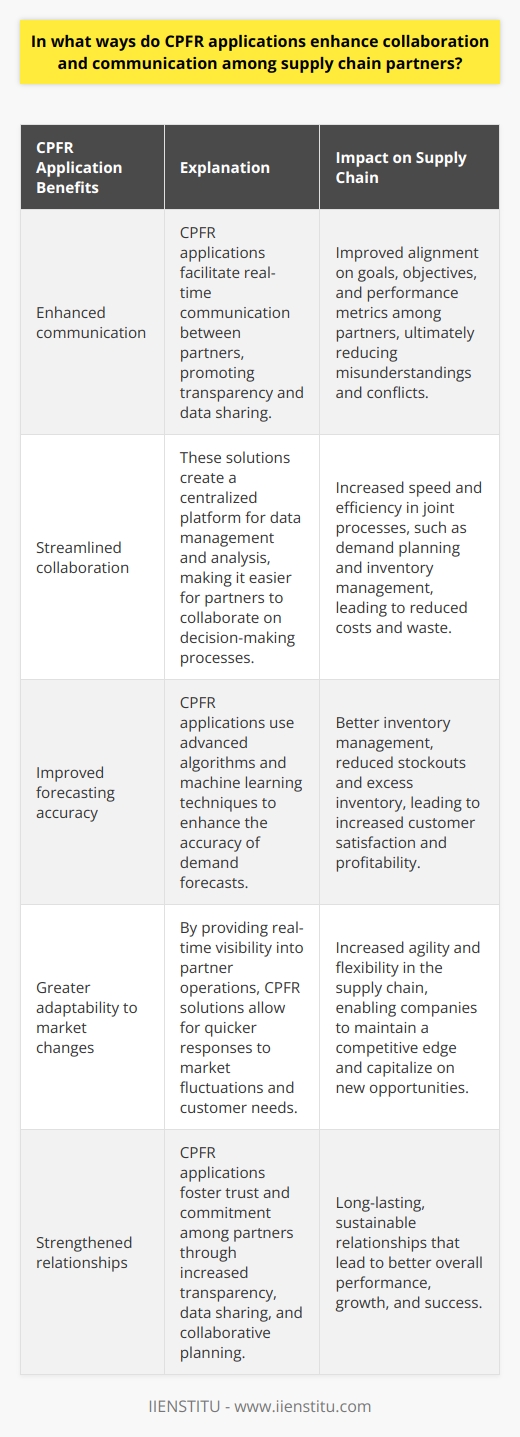
What is the role of technology in facilitating CPFR in logistics?
Role of Technology in CPFR
Enhancing Collaboration Through Technology
The role of technology in facilitating Collaborative Planning, Forecasting, and Replenishment (CPFR) in logistics is essential in promoting effective collaboration and integration among supply chain partners. One way technology enhances collaboration is through cloud-based systems, which improve communication by enabling real-time data sharing among partners. By providing access to critical information, these systems allow for better decision-making, resulting in improved supply chain performance.
Increasing Accuracy in Forecasting
In addition to facilitating collaboration, technology plays an essential role in enhancing the accuracy of forecasting. Advanced analytics and machine learning algorithms are employed to analyze historical data and identify patterns, leading to more precise demand forecasts. By incorporating relevant external factors, such as economic indicators or weather patterns, these advanced forecasting tools can further improve accuracy. This improved accuracy enables supply chain partners to optimize inventory levels, reduce lead times, and minimize the bullwhip effect.
Automating Replenishment Processes
Technology is also paramount in automating the replenishment processes within the CPFR framework. The Internet of Things (IoT) allows for the integration of smart sensors into inventory management systems. These sensors can monitor stock levels in real-time, automatically triggering replenishment orders when stocks fall below predetermined thresholds. This level of automation not only saves time and labor costs but also reduces the likelihood of stockouts and excess inventory.
Optimizing Supply Chain Coordination
Supply chain coordination is another area where technology plays a crucial role in facilitating CPFR. Through advanced tools like Enterprise Resource Planning (ERP) systems, companies can integrate all aspects of their supply chain operations – from procurement and production to warehousing and transportation. This integration enables better visibility, allowing supply chain partners to identify potential issues and bottlenecks early on, leading to more proactive problem-solving and increased efficiency.
Facilitating Performance Measurement
Finally, technology is essential in facilitating performance measurement in the CPFR framework. Key performance indicators (KPIs) are used to evaluate the effectiveness of supply chain collaboration and identify areas for improvement. Advanced data visualization tools and customizable dashboards enable supply chain partners to monitor and analyze these KPIs in real-time, ensuring continuous improvement across the entire supply chain.
In conclusion, technology plays a vital role in facilitating CPFR in logistics by enhancing collaboration, increasing forecasting accuracy, automating replenishment processes, optimizing supply chain coordination, and facilitating performance measurement. By leveraging the power of technology, supply chain partners can build resilient and responsive supply chains that drive increased efficiency, competitiveness, and profitability.
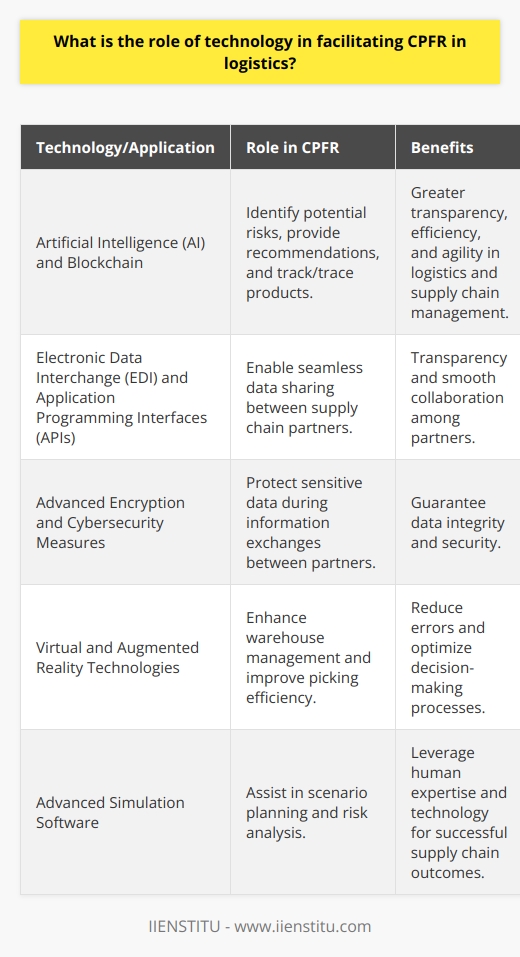
How do CPFR methodologies align with other supply chain management practices and systems?
CPFR and SCM Alignment
Collaborative Planning, Forecasting, and Replenishment (CPFR) methodologies align with other Supply Chain Management (SCM) practices and systems by promoting information-sharing, synchronized planning, and end-to-end visibility throughout the supply chain. CPFR facilitates optimal decision-making by combining the efforts of multiple stakeholders, enabling seamless integration and alignment of their individual processes and systems.
Enhancing Forecast Accuracy
A core capability of CPFR is its ability to enhance forecast accuracy by consolidating the input of multiple supply chain partners. It promotes collaboration between manufacturers, suppliers, and retailers, fostering a unified approach to demand planning and inventory management. This data-driven approach results in more accurate and reliable forecasts, reducing the propensity for issues such as stockouts, overstocks, and obsolescence.
Optimizing Supply Chain Performance
Another benefit of CPFR is its ability to optimize various aspects of supply chain performance. By coordinating the efforts of all involved parties and fostering a proactive approach to supply chain management, CPFR helps reduce lead times and improve overall responsiveness. This heightened level of agility enables firms to better adapt to fluctuating market conditions, minimizing the impact of uncertainties and disruptions on the supply chain.
Leveraging Technological Integration
CPFR's success in aligning with other SCM practices and systems depends on its ability to leverage technology for effective communication and data sharing. By utilizing advanced tools and platforms, CPFR enables seamless integration with other supply chain technologies, such as Enterprise Resource Planning (ERP), Warehouse Management Systems (WMS), and Transportation Management Systems (TMS). This interconnectedness allows for real-time data flow among various supply chain partners, ensuring a cohesive approach to SCM.
Promoting Sustainability and Risk Reduction
By facilitating strong collaboration, CPFR methods promote sustainability and risk reduction throughout the supply chain, aligning with other best practices in SCM. Through this collaborative approach, businesses are better informed of their partners' practices, encouraging greener initiatives and operational methods. Additionally, CPFR aids in managing risks through improved end-to-end visibility, enabling firms to proactively identify potential threats and adjust their strategies accordingly.
In conclusion, CPFR methodologies effectively align with other supply chain management practices and systems by fostering collaboration, enhancing forecast accuracy, optimizing supply chain performance, leveraging technological integration, and promoting sustainability and risk reduction. As a result, CPFR facilitates optimal decision-making and seamless integration, ensuring efficient and resilient supply chain operations.
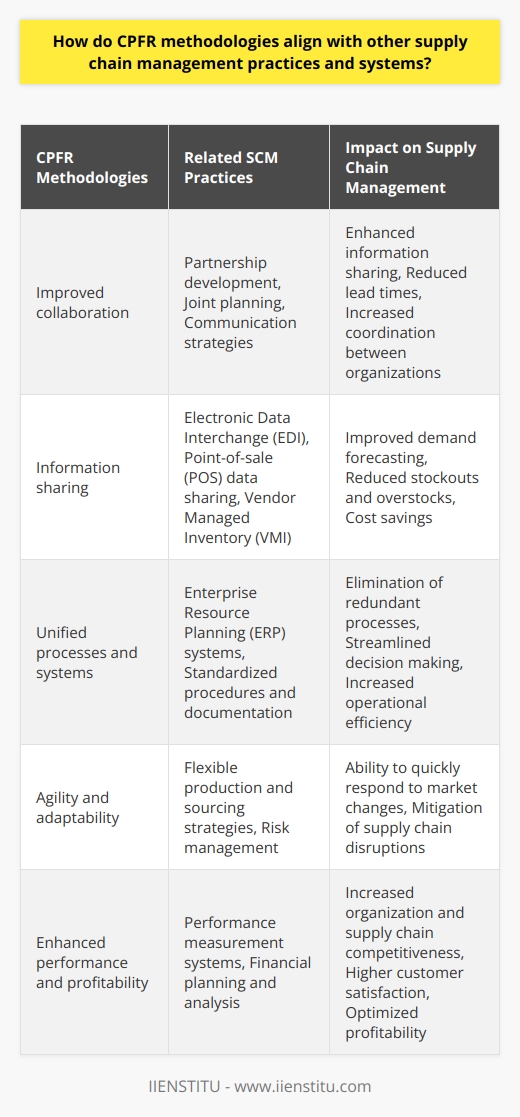
What are some common obstacles and solutions faced when implementing CPFR in logistics and supply chain management?
Subheadings: Obstacle 1: Lack of Trust, Obstacle 2: Inadequate Technology and Infrastructure, Obstacle 3: Resistance to Change, Solutions
Obstacle 1: Lack of Trust
A common obstacle faced when implementing Collaborative Planning, Forecasting, and Replenishment (CPFR) in logistics and supply chain management is the lack of trust between supply chain partners. This lack of trust can hinder the willingness of these organizations to share sensitive information, an essential component for successful CPFR implementation.
Solutions
To overcome this obstacle, organizations should focus on building trust through increased transparency, open communication, and a shared vision for successful collaboration. Establishing strong relationships between supply chain partners can lead to mutual benefits and long-term success.
Obstacle 2: Inadequate Technology and Infrastructure
Another common obstacle in implementing CPFR is inadequate technology and infrastructure. Supply chain partners may have outdated or mismatched systems, hindering the necessary flow of information needed for effective collaboration.
Solutions
To address this challenge, organizations must invest in the appropriate technology or infrastructure upgrades. These upgrades may include implementing compatible and scalable systems or utilizing cloud-based platforms to enable seamless collaboration.
Obstacle 3: Resistance to Change
Resistance to change from employees and management can pose another challenge to implementing CPFR in logistics and supply chain management. In many cases, individuals may be reluctant to adopt new processes, fearing the loss of control or job security.
Solutions
Implementing effective change management strategies can help alleviate these fears. This may involve clear communication of the benefits of CPFR, employee engagement in the planning process, and providing adequate training and support to ensure a smooth transition to new processes.
In conclusion, by addressing the common obstacles of lack of trust, inadequate technology and infrastructure, and resistance to change, organizations can successfully implement CPFR in logistics and supply chain management. This collaborative approach can lead to improved efficiency, reduced costs, and ultimately, increased competitiveness in the rapidly evolving global market.
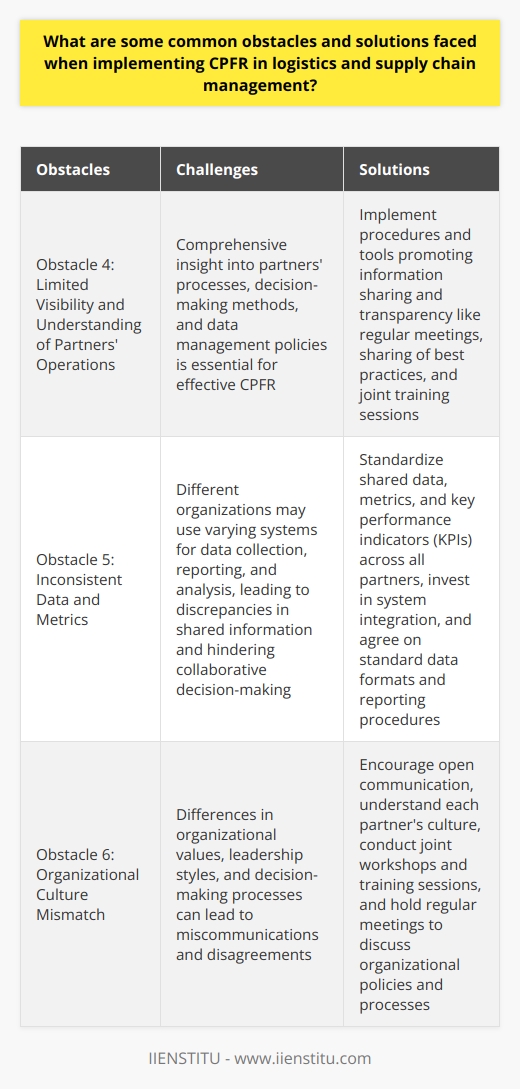
What are the benefits of a CPFR program in improving demand forecasting accuracy and reducing stockouts?
**Improved Demand Forecasting Accuracy**
The implementation of a Collaborative Planning, Forecasting, and Replenishment (CPFR) program presents numerous benefits in enhancing demand forecasting accuracy. By facilitating greater collaboration between suppliers and retailers, shared knowledge of market trends, customer preferences, and sales promotions becomes accessible. Consequently, the joint forecasting process allows for a more accurate prediction of customer demand. Furthermore, CPFR programs continuously monitor and update forecasts, ensuring the integration of real-time data to identify fluctuations in demand and allowing businesses to adapt accordingly. This constant refinement of forecasts results in reduced errors and better-informed decision making.
**Inventory Management and Stockout Reduction**
Another notable benefit of a CPFR program is its essential role in mitigating stockouts through effective inventory management. With a comprehensive understanding of customer demand, businesses can optimize their inventory levels to ensure sufficient stock is available. This improved inventory management not only reduces stockouts but also prevents overstocking – offering a more efficient utilization of warehouse resources and capital. Additionally, CPFR programs can address lead time variability, assisting both suppliers and retailers in reducing the risk of stockouts due to supply chain disruptions.
**Increased Operational Efficiency**
The adoption of CPFR programs results in significant increases in operational efficiency for both suppliers and retailers. By promoting the seamless exchange of information between the two parties, communication barriers and time-consuming processes are diminished. As a result, both suppliers and retailers can focus on value-added activities such as product development, marketing, and customer service. Moreover, the collaborative nature of CPFR programs fosters stronger relationships between supply chain partners, which can bolster long-term business growth and resilience.
**Cost Savings and Enhanced Profitability**
Lastly, the increased accuracy of demand forecasting and the reduction of stockouts through CPFR programs contribute significantly to cost savings and enhanced profitability. As businesses are better equipped to manage their inventory, resources are allocated more efficiently, reducing carrying costs and associated overhead expenses. Moreover, minimizing stockouts enhances customer satisfaction, leading to increased sales and revenue generation. These combined factors serve to elevate overall business profitability, ultimately demonstrating the value and necessity of implementing a robust CPFR program within the supply chain.

How does the implementation of CPFR promote greater transparency and trust among supply chain partners?
Transparency in CPFR Implementation
The implementation of Collaborative Planning, Forecasting, and Replenishment (CPFR) fosters greater transparency and trust among supply chain partners by facilitating open communication and data sharing. This collaborative approach enables companies to align their goals and objectives, resulting in improved overall performance and lower costs. CPFR initiatives provide an end-to-end view of the supply chain, which not only ensures transparency but also fosters a sense of ownership and accountability for all involved parties.
Role of Information Sharing
Information sharing is pivotal to CPFR, as parties exchange valuable data such as sales forecasts, inventory levels, and production schedules. Regular and accurate data sharing reduces uncertainty, as all parties have access to the same information. Consequently, each company can make better decisions, as they work with up-to-date data that is relevant to their business operations. Moreover, enhanced data accuracy encourages partners to rely on one another, ultimately fostering trust and cooperation.
Process Integration and Collaboration
CPFR integrates the supply chain processes by enabling partners to work together towards achieving mutual goals. Through joint planning, companies develop a shared vision and common objectives, further solidifying their trust in one another. As a result, supply chain partners can anticipate challenges more effectively and find solutions collectively. This collaborative environment, where each company contributes to improving the supply chain, demonstrates a commitment to the partnership and solidifies mutual trust.
Performance Monitoring and Feedback
Continuous monitoring and feedback mechanisms, integral components of CPFR, ensure that partners hold each other accountable for their performance. When companies actively evaluate and communicate their progress, transparency increases. Performance feedback allows partners to address any discrepancies or inefficiencies in a timely manner. Consequently, this environment of ongoing assessment strengthens relationships among supply chain partners by enabling them to work together to enhance their overall performance.
In summary, the implementation of CPFR cultivates greater transparency and trust among supply chain partners by streamlining communication and information sharing, integrating processes for collaboration, and emphasizing performance monitoring and feedback. This holistic approach creates an environment where supply chain partners can work together to achieve common objectives, fostering long-term relationships and enhancing overall performance.
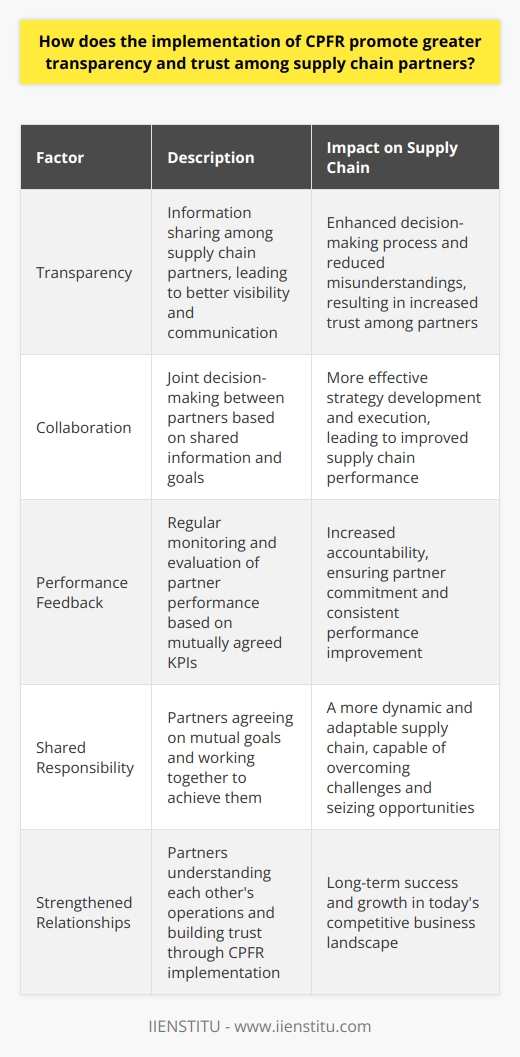
To what extent does the CPFR model contribute to the overall reduction of costs and optimization of resources in logistics management?
Impact on Cost Reduction
The CPFR model plays a crucial role in reducing costs in logistics management. Collaborative planning, forecasting, and replenishment enable companies to synchronize supply and demand, minimizing the risk of stockouts and overstocks. By working together, businesses can effectively plan production, transportation, and distribution, reducing lead times and improving the efficiency of the supply chain.
Optimization of Resources Utilization
Resource optimization is another significant aspect of the CPFR model. Collaborative efforts foster better communication between partners and help identify potential bottlenecks in the supply chain. By sharing real-time data on inventory levels, demand forecasts, and capacity constraints, companies can allocate resources more efficiently and avoid costly delays. This, in turn, leads to increased productivity and a more competitive position in the market.
Increased Forecast Accuracy
The CPFR model contributes to a higher forecast accuracy in logistics management. By sharing information and collaborating on demand forecasting, companies can develop a unified approach to predicting demand fluctuations. This helps them to make informed decisions when allocating resources and planning orders, ultimately reducing the likelihood of excess inventory and stockouts.
Enhanced Supply Chain Visibility
Improved supply chain visibility can be achieved through the CPFR model. By sharing information and collaborating on operational processes, partners in the supply chain can gain a better understanding of each other's operations and make more informed decisions. This enhanced visibility enables businesses to identify inefficiencies and optimize their supply chain to reduce costs and improve overall performance.
Strengthened Relationships between Partners
Finally, the CPFR model's emphasis on collaboration and communication helps strengthen relationships between supply chain partners. By working together, businesses develop trust and a deeper understanding of each other's needs, leading to long-lasting partnerships and a more resilient supply chain.
In conclusion, the CPFR model significantly contributes to cost reduction and resource optimization in logistics management. This collaborative approach improves forecast accuracy, enhances supply chain visibility, and strengthens partnerships, ultimately leading to a more efficient and cost-effective supply chain.
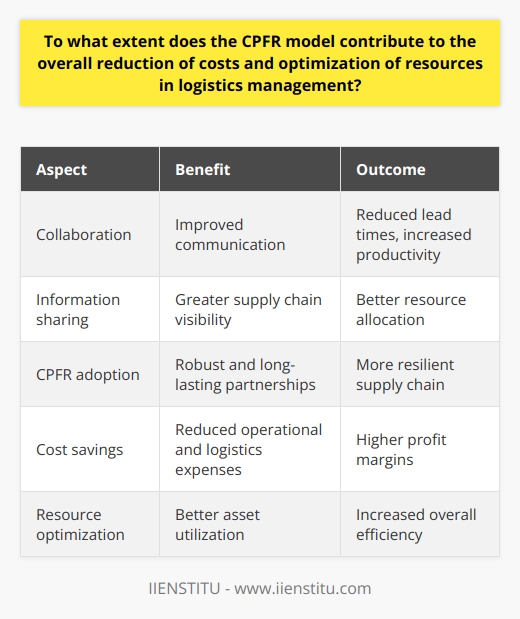
What is CPFR in logistics and what key components contribute to its efficiency in supply chain management?
Understanding CPFR in Logistics
Collaborative Planning, Forecasting, and Replenishment (CPFR) is a strategic approach in logistics that aims to enhance supply chain performance through improved collaboration and information sharing among trading partners. This system enables companies to efficiently coordinate supply and demand, ensuring timely product availability while reducing inventory levels and costs.
Key Components of CPFR Efficiency
Collaboration and Relationship Building
At the core of CPFR is fostering strong relationships between manufacturers, suppliers, and retailers. Effective communication is essential in establishing trust and commitment among partners, which results in better decision-making and problem solving across the supply chain.
Information Sharing and Integration
Sharing accurate, up-to-date information among all stakeholders is crucial for CPFR success. This includes sales data, inventory levels, capacity constraints, and other critical factors needed for accurate demand forecasting. Intelligent integration of information systems can further enhance the transparency and efficiency of data exchanges.
Demand and Sales Forecasting
Forecasting forms the basis for an efficient supply chain. By jointly analyzing sales data and monitoring market trends, CPFR partners can develop more accurate demand forecasts, leading to optimized production and inventory planning.
Synchronized and Responsive Planning
CPFR promotes a common planning process across the supply chain, ensuring all parties are aligned in their operational strategies and objectives. This synchronized planning allows for faster responses to unexpected changes in demand or supply conditions, thus enabling partners to minimize disruptions and maintain high service levels.
Continuous Improvement and Performance Measurement
An essential element of CPFR is the ongoing evaluation and refinement of processes and strategies. By utilizing performance metrics and benchmarking, trading partners can identify areas for improvement, driving continuous advancements in supply chain efficiency.
In conclusion, CPFR in logistics serves as a powerful approach to align supply chain processes through collaboration, information sharing, and synchronized planning. By fostering strong relationships and leveraging advanced forecasting techniques, CPFR enables organizations to optimize their supply chain management, delivering tangible benefits such as cost savings, risk reduction, and increased customer satisfaction.
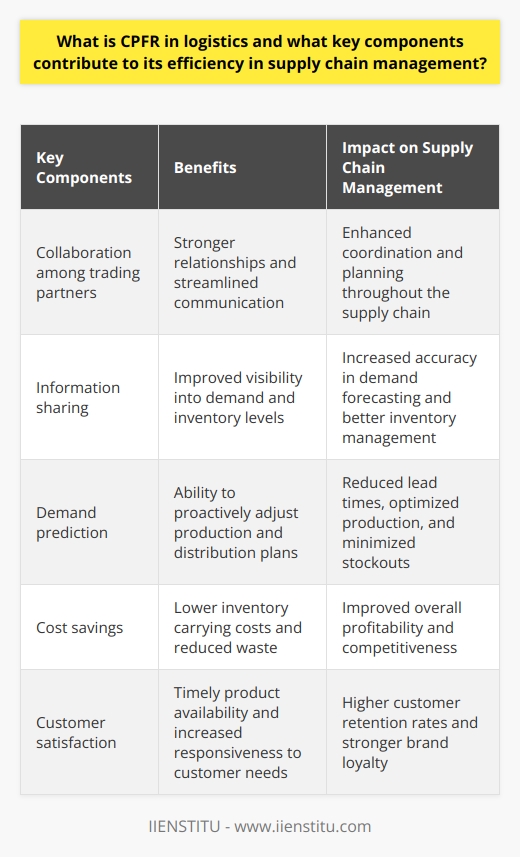
What are some examples of industries that have successfully implemented CPFR models and experienced significant benefits in their logistics operations?
CPFR Models in Retail and Consumer Goods
One industry that has effectively leveraged collaborative planning, forecasting, and replenishment (CPFR) models is the retail sector. Major firms like Walmart and Procter & Gamble have embraced CPFR practices to optimize their supply chain management processes. By closely collaborating on demand forecasting and inventory management, these companies have achieved improved product availability, lower inventory levels, and reduced logistics costs.
Collaboration in the Electronics Industry
Similarly, the electronics industry has also witnessed successful CPFR implementations. For instance, companies like Philips and Dell have integrated CPFR models into their supply chain operations. This approach has not only streamlined processes between these businesses and their suppliers but has also resulted in a reduction in stockouts and improved responsiveness to fluctuating market demand.
CPFR Benefits in the Pharmaceutical Sector
The pharmaceutical industry has also reaped significant benefits from the adoption of CPFR models. Major pharmaceutical companies, such as Johnson & Johnson, have employed CPFR practices in managing their relationships with suppliers and distributors. This collaboration has led to an enhancement in product availability, more accurate demand forecasting, and substantial cost savings in the logistics operations.
Automotive Industry and CPFR Adoption
The automotive industry, another prominent example, has seen the successful implementation of CPFR models among leading companies like Toyota and Ford. By collaborating with their suppliers and dealers on demand forecasting, production planning, and inventory management, these automotive manufacturers have experienced improved production efficiencies, reduced lead times, and optimized inventory levels.
In conclusion, the adoption of CPFR models has greatly impacted several industries, substantiating its effectiveness as a supply chain management strategy. Industries such as retail, consumer goods, electronics, pharmaceutical, and automotive have all experienced significant improvements in their logistics operations. These improvements include enhanced demand forecasting, optimized inventory levels, better product availability, and cost savings, all confirming the importance of collaborative planning, forecasting, and replenishment in today's globalized, rapidly evolving market.
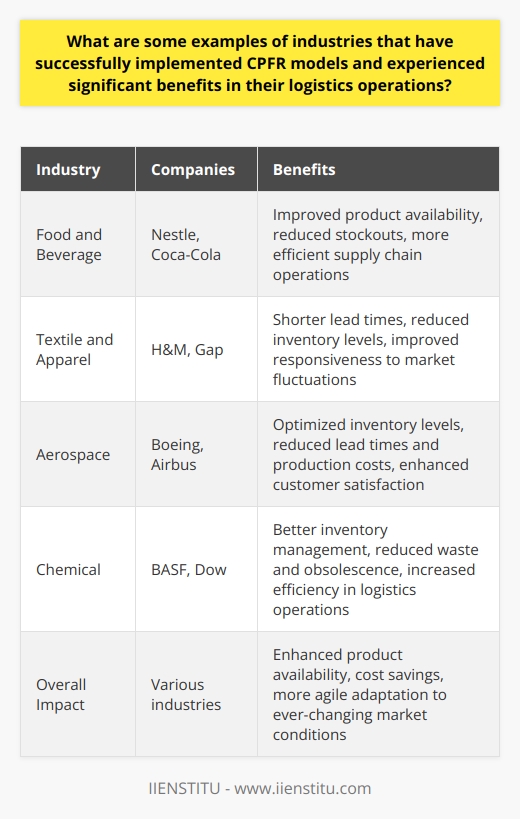
In the context of CPFR, how do logistics service providers and their clients work together to achieve improvements in supply chain performance and cost reductions?
Collaborative Planning, Forecasting, and Replenishment
In the context of Collaborative Planning, Forecasting, and Replenishment (CPFR), logistics service providers and their clients work together to achieve improvements in supply chain performance and cost reductions by implementing a set of processes that focus on data sharing, communication, and joint decision-making.
Data Sharing and Transparency
Both logistics service providers and their clients share crucial information about market forecasts, customer orders, production plans, and inventory levels. This level of transparency between the two parties allows for accurate forecasting, better planning, and efficient resource allocation.
Joint Decision-making
Joint decision-making in CPFR revolves around mutually defining performance indicators, developing joint action plans, and creating joint sales and operations plans. As a result, logistics service providers and clients can identify opportunities for improvement, effectively respond to supply chain disruptions, and conduct performance evaluations.
Demand Forecasting and Inventory Management
Logistics service providers and their clients work closely to analyze demand patterns, improve demand forecast accuracy, and avoid stockouts or excess inventory. By leveraging advanced technological tools, both parties can align inventory strategies and demand forecasting, leading to cost reductions and increased service levels.
Order Management and Fulfillment
In the CPFR model, logistics service providers and their clients collaborate to optimize order management and fulfillment processes. They review customer orders, expeditiously process, and accurately fulfill them to ensure timely order delivery and customer satisfaction. These collaborative efforts result in reduced order cycle times, minimized stockouts and fulfilled orders most cost-effectively.
Monitoring and Continuous Improvement
Lastly, both logistics service providers and their clients engage in continuous monitoring of the supply chain performance. They evaluate the effectiveness of the implemented processes, identify areas of improvement, and adjust strategies to ensure ongoing optimization and cost reduction in the supply chain.
In conclusion, through the implementation of CPFR principles, logistics service providers and their clients work in synergy to improve supply chain performance and reduce costs. This collaborative approach ensures the efficient allocation of resources, heightened responsiveness to market demands, and enhanced overall customer satisfaction.
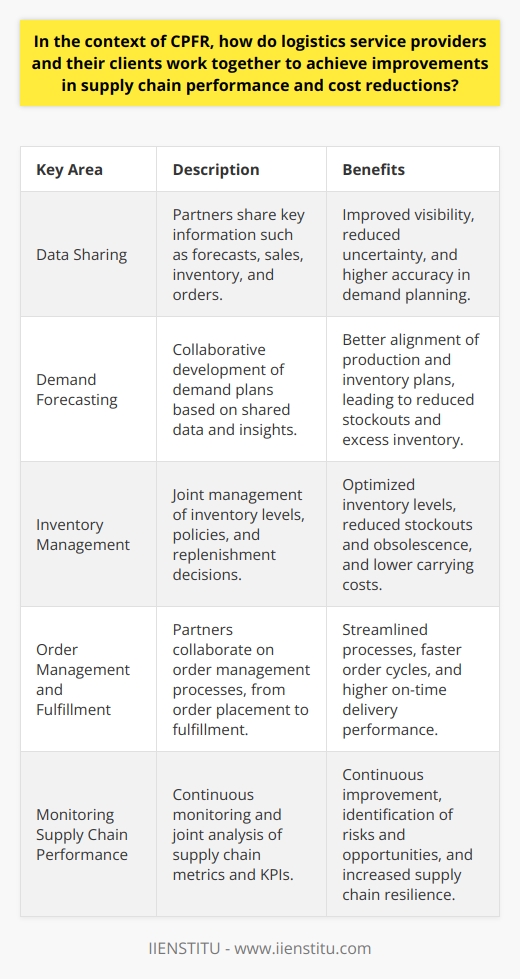
What are the benefits of CPFR model in enhancing collaboration and reducing inefficiencies in the supply chain?
Enhanced Collaboration in Supply Chain
The primary benefit of Collaborative Planning, Forecasting, and Replenishment (CPFR) model lies in how it fosters improved collaboration. With this model, all players in the supply chain share key information such as demand forecasts, production plans, and inventory levels. This transparency ensures that everyone understands the operational dynamics of the entire supply chain.
Reduced Inefficiencies
CPFR also reduces inefficiencies in the supply chain. It eradicates problems arising from poor communication, inconsistent information, and siloed operations. The model promotes synchronization and harmonization of supply chain operations, eliminating duplicated efforts and unnecessary costs.
Improved Forecast Accuracy
Adopting the CPFR model enhances the accuracy of demand forecasts. The unification of data from different players in the supply chain allows for a holistic view of market dynamics. This increased accuracy minimizes overproduction, underproduction, and ensures better order fulfilment.
Reduced Inventory Costs
The CPFR model effectively aids in inventory management. The shared visibility facilitates optimal stock levels across the supply chain, reducing unnecessary inventory costs. It's easier to balance production and demand, ensuring that goods are neither overstocked nor understocked.
Enhanced Retailer-Manufacturer Relationships
A noteworthy advantage of CPFR is its positive impact on the retailer-manufacturer relationship. The collaborative nature of the model fosters trust and encourages shared responsibility between parties. This harmony leads to improved productivity, which is beneficial for the overall supply chain.
In conclusion, the CPFR model buttresses the supply chain's structural and operational efficiency. It cultivates collaboration, minimizes inefficiencies, optimizes inventory management, and nurtures beneficial relationships between supply chain partners.
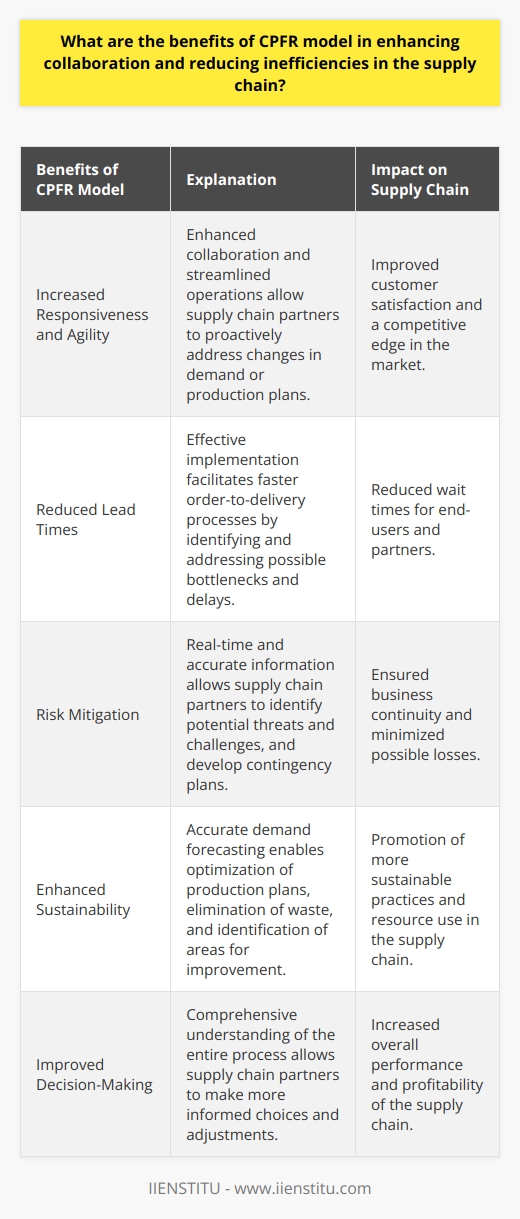
How does the integration of CPFR in logistics management contribute to better demand planning and inventory control?
Integration of CPFR in Logistics Management
Bringing CPFR (Collaborative Planning, Forecasting and Replenishment) into logistics management brings several benefits. It can improve both demand planning and inventory control significantly.
Enhancement of Demand Planning
CPFR can help in predicting and planning the forthcoming demand effectively. By integrating data from various sources, it generates a more accurate forecast. Thus, it reduces the risk of overproduction or underproduction. Improved demand planning can lead to higher customer satisfaction by ensuring the availability of products when customers need them.
Improved Inventory Control
Equally, CPFR can contribute positively to inventory control. It facilitates better synchronization between manufacturers and retailers. This synchronization helps in controlling the inventory levels, avoiding stock-outs and overstocks. An effective inventory system will translate into lower holding costs and increased revenue. Efficient inventory control saves time, reduces operating costs, and contributes to better cash flow management.
CPFR and Decision Making
In a nutshell, integrating CPFR in logistics management leads to data-driven and more accurate decision-making processes. It bridges the gap between demand and supply, ensuring that the right products are available at the right time. CPFR in logistics fosters better communication between suppliers, retailers, and consumers, creating a more responsive and flexible supply chain.
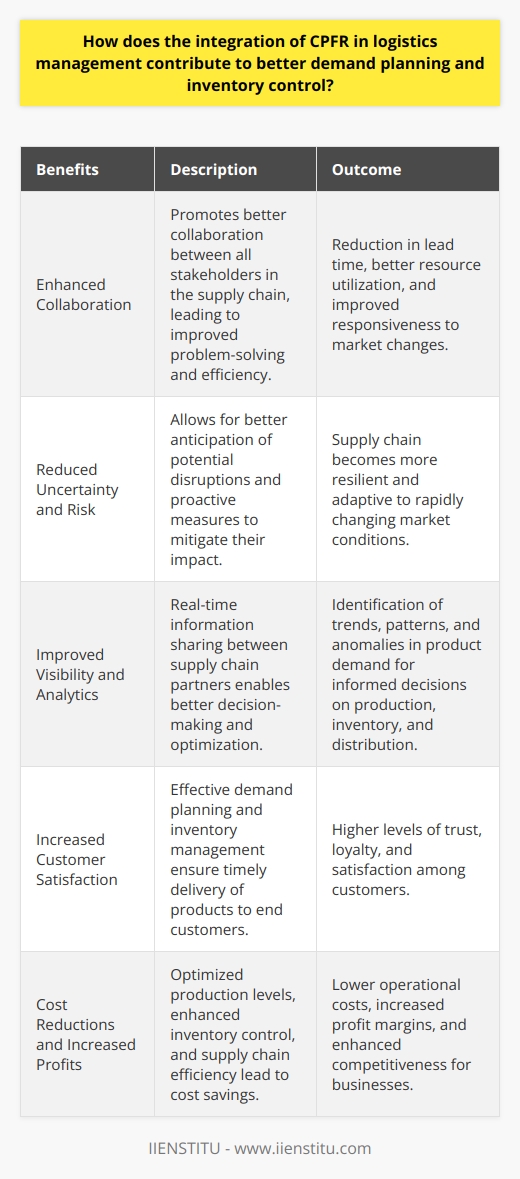
In what ways does the implementation of the CPFR model promote overall visibility and responsiveness in supply chain management?
Enhanced Visibility through CPFR
The Collaborative Planning, Forecasting, and Replenishment (CPFR) model can increase overall visibility in supply chain management. It does this by establishing a shared view of supply-demand predictions among supply chain partners. In turn, this supports a unified planning and decision-making process.
Improved Inventory Management
An additional aspect of CPFR is inventory management. Through real-time sharing of inventory levels, retailers and suppliers can anticipate demand changes. This prevents stock outs or overstocking, thereby increasing responsiveness and efficiency.
Demand Forecasting and Responsiveness
Another key area where CPFR promotes responsiveness is in demand forecasting. By fostering collaborative forecasting, CPFR enables parties to adjust quickly to changes in demand. Furthermore, this collaborative approach reduces the risk of forecast inaccuracy, ensuring optimal resource allocation.
Facilitated Communication
CPFR also promotes transparency in supply chain management by facilitating two-way communication between involved parties. This increased communication leads to improved trust and cooperation. As a result, problem-solving becomes more effective and the supply chain more resilient.
In summary, the CPFR model promotes overall visibility and responsiveness in supply chain management through its collaborative approach. It fosters shared decision-making, enhances inventory management, facilitates accurate demand forecasting, and encourages effective communication. This results in a highly efficient, responsive, and resilient supply chain.
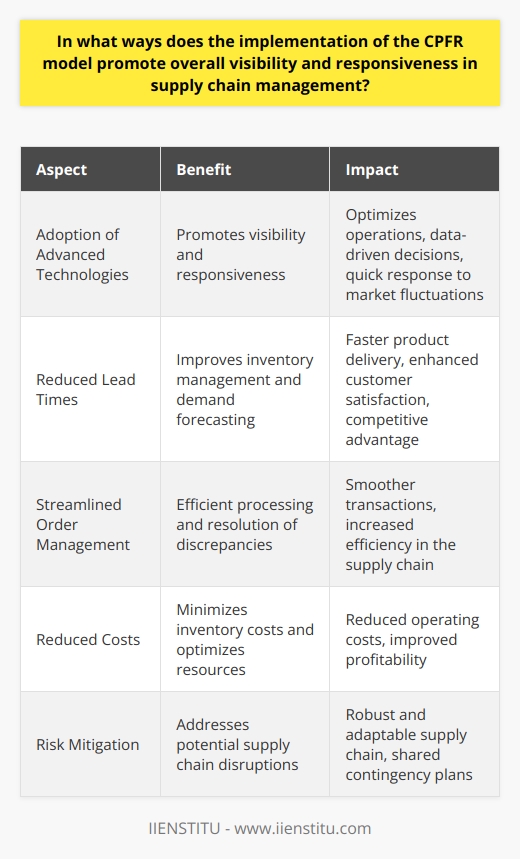
What is CPFR and what are four benefits that can be achieved by implementing a successful CPFR program?
Understanding CPFR
Collaborative Planning, Forecasting, and Replenishment (CPFR) is a business practice that unites partners in the supply chain process. CPFR allows companies to harmonize data, strategies and execution procedures with their partners.
Benefit 1: Enhanced Forecast Accuracy
By implementing CPFR, businesses can improve their forecast accuracy. Companies can evaluate historical data and current market trends. Consequently, this minimizes the chances of over- or under-stocking.
Benefit 2: Improved Profit Margins
Secondly, CPFR contributes to better profit margins. Waste reduction in product life cycles and the supply chain unlocks savings. Therefore, profit margins expand, increasing a company's bottom line
Benefit 3: Reinforced Customer Loyalty
Customer satisfaction levels rise with a successful CPFR program. Faster, more reliable deliveries lead to higher customer loyalty. Therefore, it aids businesses in building strong customer relationships.
Benefit 4: Increased Operational Efficiency
Finally, CPFR can elevate operational efficiency across businesses. Enhanced data sharing and harmonized operations can greatly minimize operational inefficiencies. Consequently, high operational efficiency results in cost savings.
In conclusion, CPFR benefits not only a company's internal operations, but also its relationships with partners and customers. By improving forecast accuracy, heightening profit margins, reinforcing customer loyalty and increasing operational efficiency, businesses can expect a robust return on their investment.
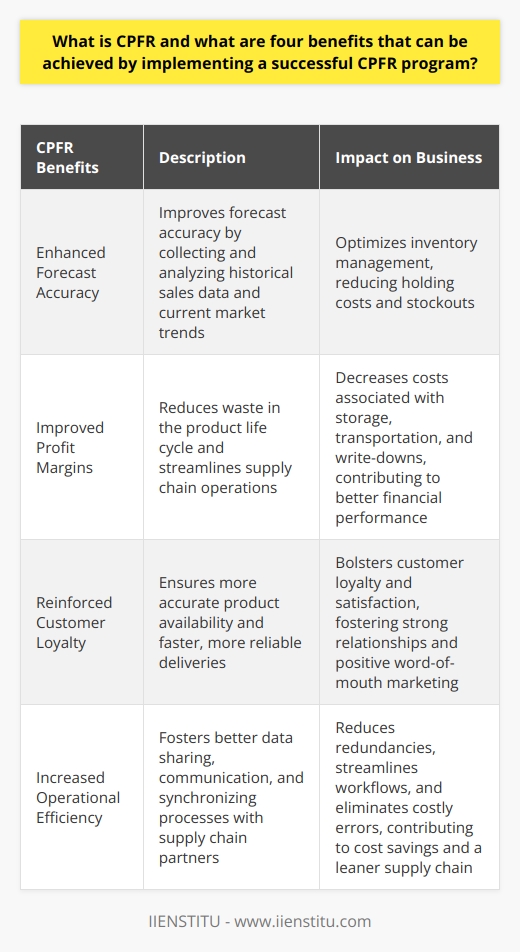
How does CPFR in logistics address common challenges faced by organizations in managing their supply chains?
Enhancing Visibility and Collaboration
The Collaborative Planning, Forecasting, and Replenishment (CPFR) model in logistics directly engages with typical supply chain problems through fostering heightened visibility and collaboration. It connects all stakeholders in the supply chain, offering an integrated view of inventory levels, orders, and sales forecasts.
Improved Demand Planning and Forecasting
CPFR improves demand planning and forecasting accuracy. By synchronizing operations and sharing information between suppliers and retailers, it reduces discrepancies and promotes more precise forecasting. This results in reduced stockouts and overstocks, an essential benefit for organizations.
Enhancing Operational Efficiency
Besides, efficiency in operations is another aspect impacted positively by CPFR. By standardizing processes and integrating systems, the model eliminates redundancy, reduces lead times, and optimizes stock levels. These improvements can lead to cost reductions and better overall performance.
Reduction in Stock-outs and Overstocks
Furthermore, the CPFR model also addresses the challenge of stock-outs and overstocks. Shared visibility of real-time demand information among supply chain partners can help adjust production and inventory levels accordingly, avoiding costly surplus or shortage situations.
Supply Chain Risk Mitigation
Finally, CPFR in logistics helps tackle supply chain risks by increasing transparency. Shared information allows partners to detect potential issues in advance and act proactively. The synchronized planning also helps spread risks more evenly across the supply chain, improving its resilience.
In conclusion, CPFR offers a comprehensive tool for organizations to cope with common supply chain challenges. Its strengths lie in promoting collaboration, enhancing forecasting accuracy, improving operational efficiency, and mitigating risks, which can yield significant benefits for all supply chain stakeholders.
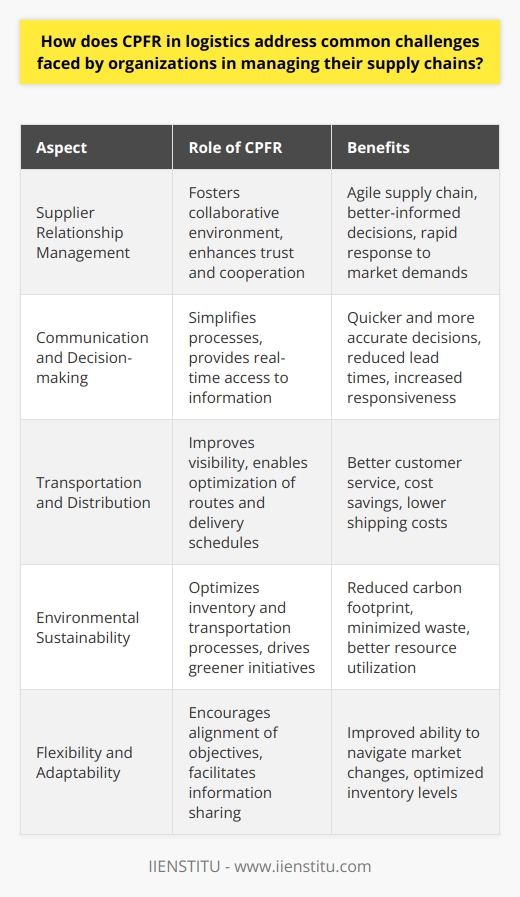
What are the advantages of incorporating CPFR models into logistics management, and how do these benefits impact overall supply chain performance?
Increased Efficiency in Inventory Management
Incorporating CPFR (Collaborative Planning, Forecasting, and Replenishment) models into logistics management has several benefits. The most significant advantage is the increased efficiency in inventory management. The use of CPFR models facilitates the accurate prediction of customer demand, thereby reducing the risk of overstocking or understocking.
Enhanced Supplier and Retailer Collaboration
Besides, CPFR models promote stronger collaboration between suppliers and retailers. Both parties can access shared data in real-time. This practice leads to better forecasting, smoother replenishment processes, and overall improved supply chain coordination.
Accelerated Order Fulfillment
By incorporating CPFR models, businesses can accelerate their order fulfillment processes. These models help to streamline the ordering process by predicting demand patterns accurately. This ensures timely product availability and leads to improved customer satisfaction.
Reduced Costs and Greater Profitability
Additionally, using CPFR models can significantly reduce costs. These models minimize inventory holding costs due to accurate forecasting. They also lower the chance of lost sales from stockouts. Therefore, incorporating CPFR models can lead to increased profitability.
Positive Impact on Supply Chain Performance
In essence, incorporating CPFR models into logistics management positively impacts overall supply chain performance. These models enhance efficiency, promote collaboration, accelerate order fulfillment, and reduce costs, leading to improved operational performance and profitability. Therefore, CPFR models play a crucial role in achieving successful logistics management, making them a worthy investment for businesses striving for supply chain excellence.
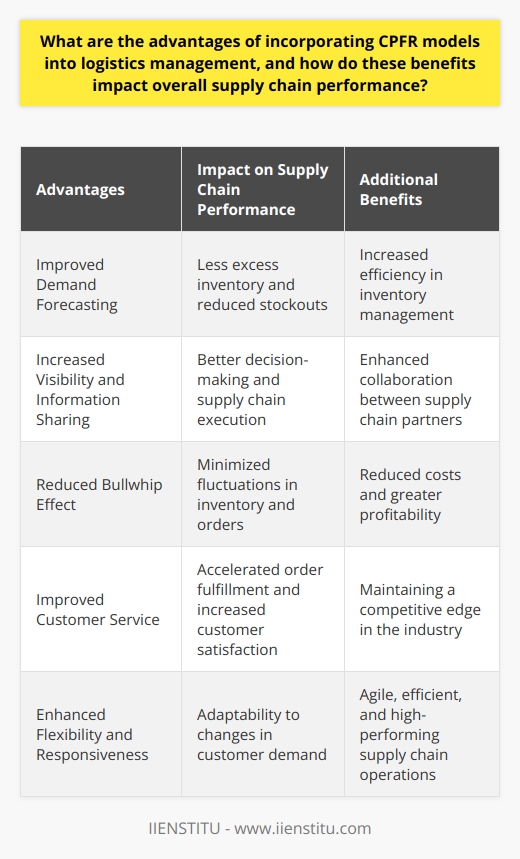
What are the benefits of CPFR in supply chain management for optimizing resource utilization and mitigating potential risks?
Optimized Resource Utilization
One significant benefit of Collaborative Planning, Forecasting and Replenishment (CPFR) in supply chain management is the optimized resource utilization. CPFR incorporates collaborative technology to forecast demand accurately, reducing overproduction or stockouts. It improves coordination amongst the supply chain partners, ensuring on-time delivery of goods and services.
Inventory Management
With the integration of CPFR, the companies can manage inventory in an efficient manner. This approach reduces the risk of overstock or understock situations. Ultimately, it saves storage costs and safeguards against product obsolescence.
Demand Forecasting
CPFR generates accurate demand forecasts by collating data from multiple sources. It reduces uncertainties associated with traditional demand planning methods. This helps firms in resource allocation, reducing waste, and enhancing customer satisfaction by ensuring product availability.
Risk Mitigation
In addition, CPFR plays a crucial role in mitigating potential risks in supply chain management. By enabling real-time visibility across the supply chain, it allows quick response to unforeseen situations, mitigating risks of delays or disruptions. Consequently, it promotes business continuity and strengthens the resilience of the supply chain.
In summary, CPFR significantly benefits supply chain management by optimizing resource utilization and mitigating potential risks. By leveraging collaborative technologies, it enhances forecast accuracy, improves inventory management and promotes risk mitigation.
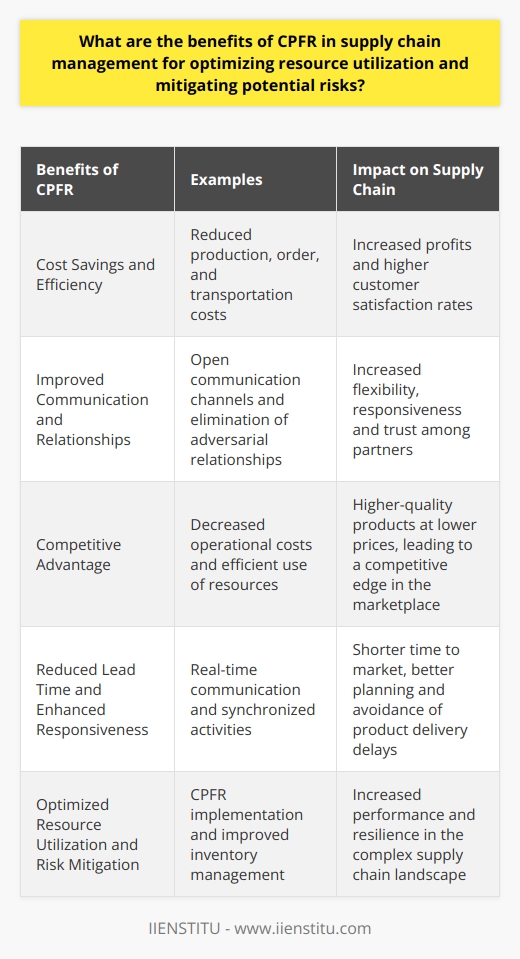
How does the implementation of CPFR impact the efficiency and flexibility of a company's logistics operations, particularly in response to unforeseen disruptions or market changes?
Enhancing Logistics Efficiency
The implementation of Collaborative Planning, Forecasting, and Replenishment (CPFR) can notably boost a company's logistics efficiency. It enables companies to swiftly respond to changes in demand with real-time data. With this feature, businesses can adjust their inventory strategies instantly, thereby maximizing resource utilization and reducing excessive inventory costs.
Promoting Flexibility in Operations
Furthermore, CPFR espouses a high level of flexibility in logistics operations. It accommodates necessary modifications in supply chain management to meet emerging market demands or respond to disruptions. Companies can reconfigure their supply chains, reallocate resources or adjust delivery schedules, ensuring the continuous delivery of products and services.
Mitigating Disruptions
Harnessing CPFR also creates an environment that is resilient to unforeseen disruptions by enabling early detection of potential bottlenecks and risks. Automated alerts allow businesses to take proactive measures, averting potential crises. By inculcating visibility and transparency, CPFR helps in fostering strong supplier relationships, thereby ensuring consistent supply flow.
Responding to Market Changes
CPFR stands instrumental in enabling businesses to respond efficiently to market changes. It heightens the agility with which they can adapt supply chain operations in response to fluctuations in demand or other market shifts. This allows businesses to create highly responsive supply chains with a capacity to recognize and respond to changes rapidly.
In conclusion, the implementation of CPFR can significantly amplify the efficiency and flexibility of a company's logistics operations, particularly in responding to unforeseen disruptions or market changes. It necessitates investment in appropriate technology and infrastructure. However, the long-term benefits surpass the initial costs, rendering CPFR a crucial component in contemporary supply chain management.
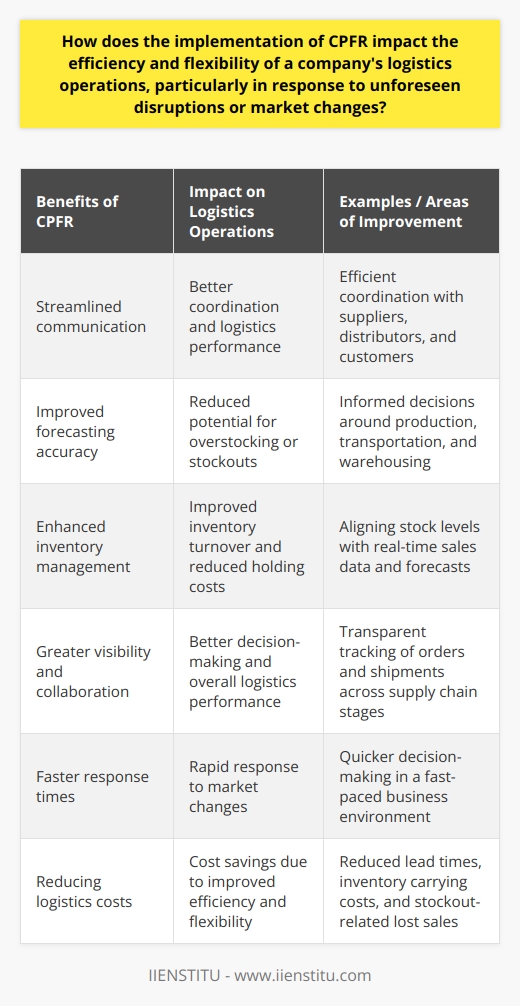
What are the key success factors and potential challenges in adopting CPFR as a strategic approach to logistics management and supply chain integration?
Key Success Factors for CPFR Adoption
Successful implementation of Collaborative Planning, Forecasting, and Replenishment (CPFR) depends on several elements. Firstly, strong trust and communication between all parties involved are crucial. This paves the way for sharing sensitive information, such as sales and inventory figures, vital for effective collaboration. Secondly, CPFR demands organizational alignment. All parties must agree on a unified vision, strategy, and goals to avoid conflicts. Finally, adequate technology infrastructure is critical. IT systems must be capable of supporting real-time data exchange, analysis, and collaboration.
Challenges in Adopting CPFR
Despite the promised benefits, several potential challenges may arise in adopting CPFR. One major challenge is achieving the necessary level of trust among partners. Since CPFR involves sharing confidential information, trust issues can emerge. Also, different organizations may have different strategies, making alignment difficult. On a technical level, firms may lack the necessary IT infrastructure to support real-time data exchange. Existing systems might not be capable of handling vast amounts of data, leading to operational inefficiencies.
Impact on Logistics Management and Supply Chain Integration
CPFR can significantly impact logistics management and supply chain integration. If implemented correctly, it can lead to improved forecast accuracy and lower inventory levels. However, potential challenges such as trust issues, alignment conflicts, and technical inefficiencies can hinder these benefits. Overcoming these issues requires focus on building trust, aligning strategies, and investing in the necessary technology infrastructure. Thus, while CPFR can potentially revolutionize logistics and supply chain management, its deployment needs careful planning and management.


